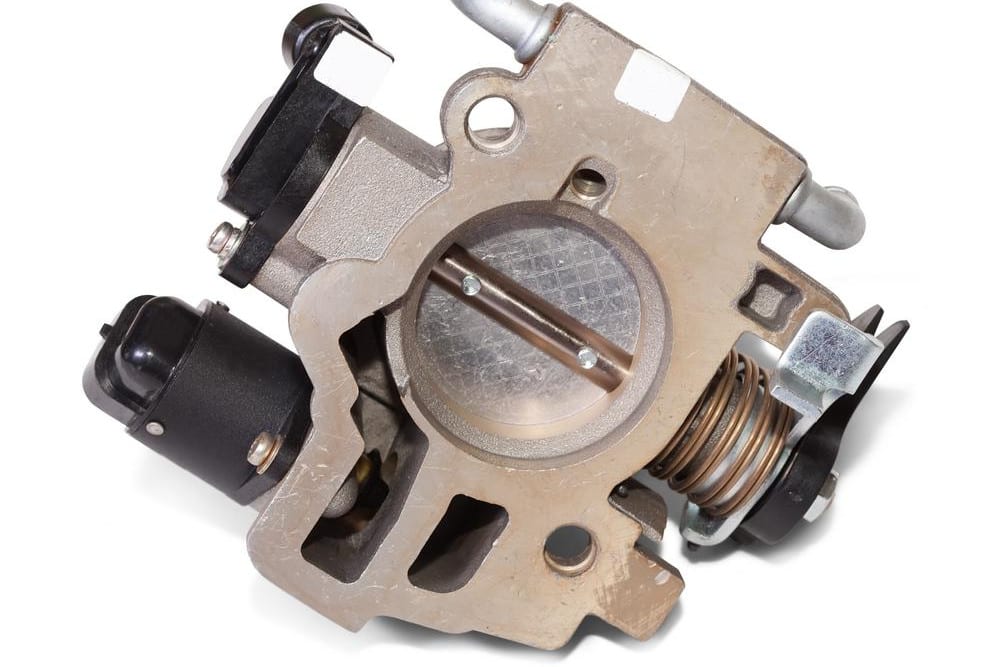

Whether you drive a Kia or a 10,000 horse power Top Fuel Dragster, having a fully functional throttle return spring can save your life. On top of the throttle body of a fuel injected motor or carburetor is a butterfly valve, which opens when the accelerator pedal is pushed and the cable pulls it open. By opening this valve, you are allowing more air to pass into your engine. The butterfly valve then closes when you take your foot off the pedal. Involved in this process of closing the valve is the throttle return spring as it actually closes the valve. When it works properly, it helps to slow the vehicle down. When it's broken or wearing out, the throttle may stick wide open, causing a potentially dangerous situation.
The throttle return spring is attached to the throttle cable or it can be attached to the throttle body or carburetor. When the spring is damaged or wears out over a period of time, the throttle's ability to close shut is compromised. Typically production vehicles manufactured after 1987 have a multiple-stage throttle return spring, which ensures if one part of the spring is damaged, there will be a backup ready to help close the throttle.
Most of today's cars don't have issues with the throttle return springs, however, it is mechanical and can wear out over a period of time or due to added exposure to heat, oil, debris or other factors. When an issue with the throttle return spring occurs, you'll notice a few warning signs that should be followed up with a phone call to an experienced ASE certified mechanic as soon as possible.
Listed below are a few of the warning signs that a problem with a throttle return spring exists.
1. Engine RPM remains high after lifting off accelerator
As indicated above, the job of the throttle return springs is to "return" the throttle to a closed position. When the spring is damaged, the throttle body will remain open until either the pedal is manually drawn back by a driver's foot or gravity takes over and helps to close the throttle. However, when an engine is running, it creates a vacuum which wants to draw air into the intake, making it very difficult for the throttle blades to close on their own. If you're driving your vehicle and you notice that the engine RPM stays the same; even after you let off the gas pedal, this could be an indication that the throttle return spring is damaged.
If this happens while you are driving the first thing you don't want to do is panic. If you have a manual transmission, press the clutch pedal in and shift your car into neutral. This will allow you to come to a safe stop. If you have an automatic transmission, you can also shift into neutral gear and slowly apply pressure to the brake pedal. Once you come to a stop, try to turn the engine off. As soon as you stop, call a towing company and have your car brought home; as you don't want to drive the vehicle again until it is fully inspected by a professional mechanic.
2. Gas pedal feels spongy
Besides returning the throttle to the closed position, the throttle return spring also provides some strength to the throttle pedal. Most of today's modern cars are electronically controlled, so the pedal is very easy to activate and close. On older vehicles with the mechanical throttle linkage, the throttle return spring keeps the pedal solid and very easy to control. If the throttle pedal is spongy when you depress it, it could be caused by a broken throttle return spring or one that is wearing out.
3. Gas pedal doesn't return to normal position
Finally, if you release your foot from the accelerator and the pedal doesn’t return to the normal position, this is often a signal that the throttle return spring is damaged and needs to be replaced. A local ASE certified mechanic will know how to replace the throttle return spring on any vehicle as this is one of the first things taught in automotive class due to the serious nature of a mechanical failure with this device.
Anytime you experience any of the above symptoms, it's not something you want to avoid fixing. A throttle return spring is a very inexpensive part, and the cost to replace this unit is very affordable when you consider the price hikes associated to a vehicle accident. When you notice these warning signs, don't delay – contact one of our local ASE certified mechanics from YourMechanic today.



